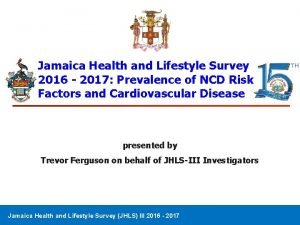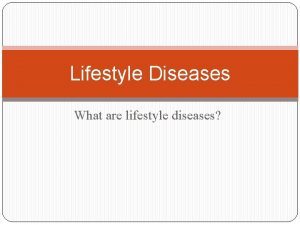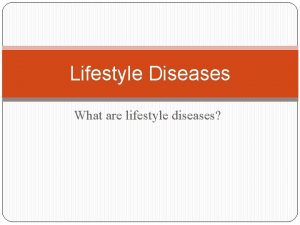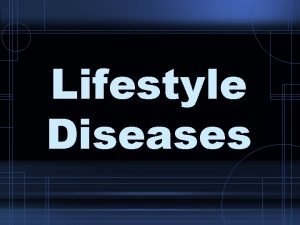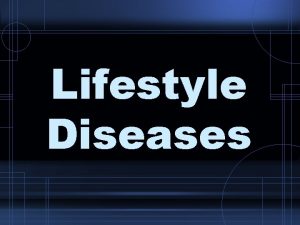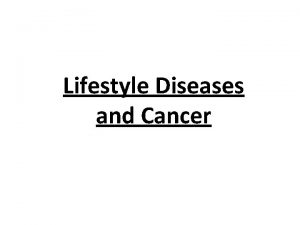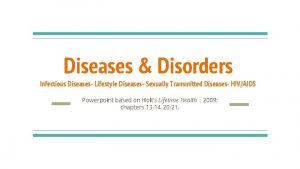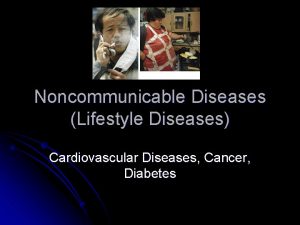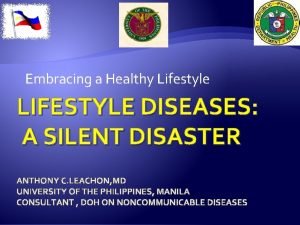Social diseases civilization diseases or lifestyle diseases Ph













- Slides: 13

Social diseases, civilization diseases or lifestyle diseases? Ph. D. Ledina Karteri Hoxha European University of Tirana, Albania Dr. Armando Hoxha Abdominal Surgeon, “Nene Tereza” Hospital Center, Tirana, Albania

Introduction

• Un-met universal health needs in modern civilisation • 1. Lack of physical activity • 2. Unnatural diet • 3. Unclean air • 4. Other un-met health needs


Lack of physical activity • is associated with a wide range of diseases and other health problems: • obesity, • heart disease, • diabetes, • high blood pressure, • osteoporosis, • depression

Unnatural diet VS • • • obesity, high blood pressure, heart disease, diabetes and depression

Unclean air • Clean air (not contaminated with hydrocarbons, sulphur oxides, lead etc. ) • Residents in urban centres are exposed to a range of air pollutants: • fine particles, carbon monoxide, oxides of nitrogen, hydrocarbons, volatile organic compounds, ozone and lead. • Unclean air – from tobacco smoking and air pollution – is an important cause of chronic respiratory disease, heart disease and cancers.

Un-met universal psychosocial needs, associated with consumer culture, alcohol and other drug use. • is also associated with diseases including liver diseases such as hepatitis, cirrhosis and cancer, and infectious diseases from risk behaviours such as needle sharing and unprotected sexual contact (hepatitis A, B, C and HIV infection).

Globalization


• This data is given as the total across all ages, and both sexes. • Causes of death varies notably between age groups. • At a global level we see that the majority of deaths are attributed to the category of non-communicable diseases (NCDs); these are chronic, long-term illnesses such as cardiovascular diseases (including stroke), respiratory disease, cancers and diabetes. • Collectively NCDs account for more than 70 percent of global deaths.

Conclusions • We need to re-think our urban environments. In future, we should build our cities in ways that provide opportunities for plenty of physical activity in the way we inhabit our places. • Certainly, it is important to allow easy access for people with physical impairments. It is possible to achieve both these objectives simultaneously. • We should take stock of our food supply and our food “culture”. Natural food is a universal health need, and it also provides wonderful opportunities for social connection, interaction and conviviality.

 Lifestyle modern
Lifestyle modern Social hierarchy ancient rome
Social hierarchy ancient rome Social thinking and social influence in psychology
Social thinking and social influence in psychology Social thinking social influence social relations
Social thinking social influence social relations Lecture on healthy lifestyle
Lecture on healthy lifestyle Write a c for countable nouns or a u for uncountable nouns
Write a c for countable nouns or a u for uncountable nouns Jamaica health and lifestyle survey
Jamaica health and lifestyle survey Lifestyle hobbies
Lifestyle hobbies Healthy eating sentences
Healthy eating sentences Bilungang panlibangan
Bilungang panlibangan Oxid wms
Oxid wms Domestic discipline lifestyle
Domestic discipline lifestyle Valstm
Valstm Chapter 1 making wellness a lifestyle
Chapter 1 making wellness a lifestyle






